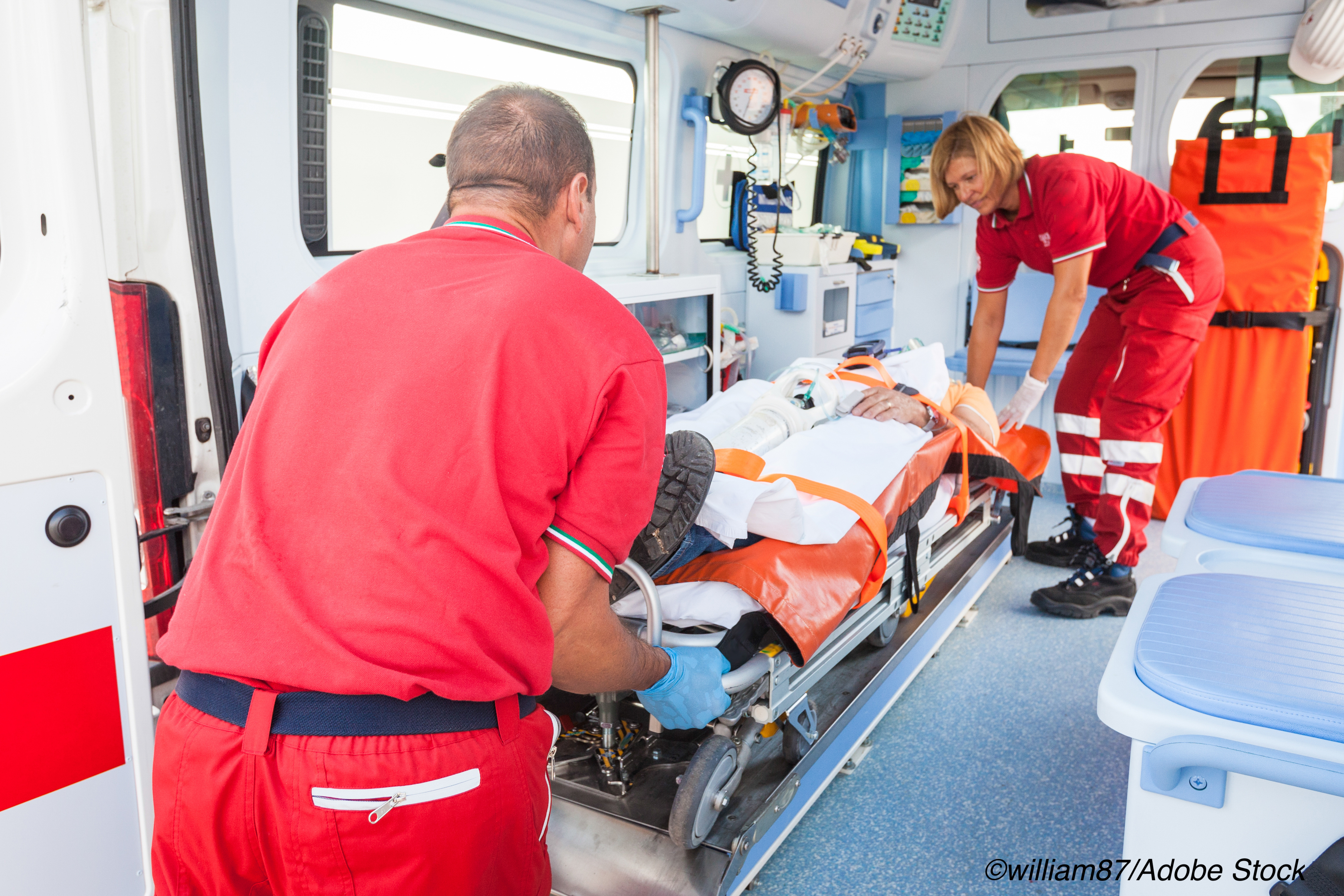Seven pre-hospital large vessel stroke prediction scales offered good results in the EMS setting, although two scales in particular stood out, according to a head-to-head comparison study.
In the prospective, cohort study of emergency medical services-initiated acute stroke code for symptomatic large anterior vessel occlusion (sLAVO), accuracy of the scales ranged from 0.79 to 0.89, reported Nyika D. Kruyt, PhD, of Leiden University Medical Center in Leiden, the Netherlands, and co-authors.
Two scales yielded the highest scores, they stated in JAMA Neurology: the Los Angeles Motor Scale (LAMS) from the U.S., and Rapid Arterial Occlusion Evaluation (RACE) from Spain.
The other five scales assessed were the Cincinnati Stroke Triage Assessment Tool (C-STAT, formerly CPSSS), the Prehospital Acute Stroke Severity (PASS) from Denmark, the Field Assessment Stroke Triage for Emergency Destination (FAST-ED) from Brazil, the gaze-facial asymmetry-level of consciousness-extinction/inattention (GACE) from the Netherlands; and gaze-face-arm-speech-time (G-FAST).
The authors also reported that sensitivity of all the scales ranged from 38% to 62%, while specificity ranged from 80% to 93%, and scale feasibility rates ranged from 78% to 88%. The PASS scale demonstrated the highest feasibility rate, they added, explaining that “The PASS scale had the highest reconstruction rate, probably as a result of fewer items that needed to be assessed compared with the other scales.”
Kruyt’s group pointed out that there’s no shortage of clinical prediction scales available, but the majority were validated in the hospital and not in the pre-hospital EMS setting. sLAVO occurs in as many as 15% of suspected acute stroke patients, but because “sLAVO cannot be reliably identified in the ambulance,” these patients often land at the nearest hospital to undergo intravenous thrombolysis (IVT) and endovascular thrombectomy (EVT).
EVT “can only be given to a subset of patients with [sLAVO]… EVT is an elaborate treatment and, therefore, restricted to comprehensive stroke centers (CSCs) with EVT facilities… Prehospital identification of patients with sLAVO enabling direct allocation to a CSC would greatly reduce delays to EVT treatment and improve clinical outcomes.” they stated.
Study participants were recruited from The Hague and the Leiden regions from July 2018 to October 2019. Participants were identified when an EMS-initiated acute stroke code was activated if there was a prehospital suspicion of acute stroke with a FAST or other focal neurologic symptoms.
The EMS paramedics were instructed to complete an on-site application, or during transport, for each EMS-initiated acute stroke code. The application consisted of 10 to 13 items to structure neurologic observations, enabling reconstruction of the seven prediction scales according to the authors’ scoring instructions and prespecified cutpoints.
Of the 2,812 acute stroke codes collected during the study period, more than a quarter were excluded — a study limitation — because no application was used or no clinical data were available, according to the authors. Ultimately, 2,007 patients (mean age 71.1; 50.9% men) were included in the analyses. The study’s primary outcome was sLAVO as assessed by the stroke team treating the patient and with radiologic verification.
Kruyt and co-authors explained that feasibility of a stroke prediction scale in the field was determined by the cutoff reconstruction rate, defined as the proportion of acute stroke codes for which the authors’ prespecified scale’s cut point could be determined with the available data.
They reported the following for the best, and worst, scoring prediction scales:
- RACE ≥5: Accuracy 0.88 accuracy, 0.56 sensitivity, 0.90 specificity.
- LAMS ≥4: 0.89, 0.38, 0.93.
- C-STAT ≥2: 0.79, 0.62, 0.80.
- PASS: ≥2: 0.81, 0.55, 0.83.
The authors noted that in previous research, the RACE scale had the lowest feasibility rate at 40%, but this increased to 78% in a later study, which suggests that feasibility can improve with further training and familiarity for EMS paramedics.
Study limitations include the fact that other prediction scales have been developed since the study was performed; CT angiography was used to determine the presence of sLAVO; and the applications used by the investigators contained more items than the original scales, which could have negatively influenced feasibility.
Still, the research is “tremendous work in advancing the state of this science,” stated Kori S. Zachrison, MD, MSc, of Massachusetts General Hospital in Boston, and Pooja Khatri MD, MSc, of the University of Cincinnati, in an editorial accompanying the study. “Seemingly minor differences in test characteristics have the potential to make a substantial difference for patients.”
They praised the authors in particular for recognizing that in “addition to accuracy, consideration of feasibility is critical when evaluating scales for the prehospital setting. Implementation should not place an undue burden on paramedics in the uncontrolled prehospital environment and amidst the various demands of the on-scene evaluation and transport of a patient who is in critical condition.”
Zachrison and Khatri also said that more needs to be done in terms of future stroke prediction tools, such as the incorporation global positioning technology, regional patient characteristics, and local hospital resources and quality measures.
-
In patients with acute stroke codes, seven prediction scales showed good accuracy scores, high specificity, and low sensitivity.
-
The Los Angeles Motor Scale and the Rapid Arterial Occlusion Evaluation scales yielded the highest scores, while the Prehospital Acute Stroke Severity scale had the highest feasibility rates.
Shalmali Pal, Contributing Writer, BreakingMED™
Kruyt reported support from the Dutch Brain Foundation, the Dutch Innovation Funds, and Health-Holland. A co-authors reported support from the Dutch Heart Foundation and the Netherlands Organization for Health Research and Development (ZonMw).
Zachrison reported support from the Department of Emergency Medicine at Massachusetts General Hospital, the Agency for Healthcare Research and Quality, the NIH, CRICO, and the American College of Emergency Physicians. Khatri reported support from, and/or relationships with, Cerenovus, Nervive, the NIH, Lumosa Therapeutics, DiaMedica Therapeutics, and Bayer.
Cat ID: 254
Topic ID: 253,254,254,791,8,38,192,925


